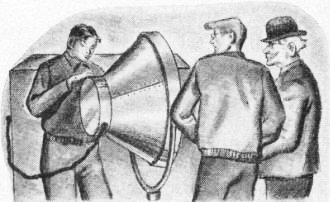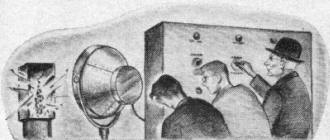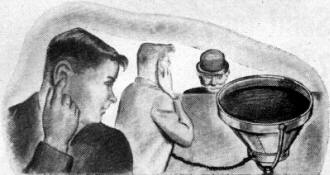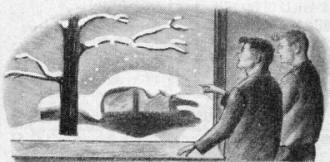|
December 1960 Popular Electronics
 Table
of Contents Table
of Contents
Wax nostalgic about and learn from the history of early electronics. See articles
from
Popular Electronics,
published October 1954 - April 1985. All copyrights are hereby acknowledged.
|
When this was first
published, we moving into the
colder days of the year in the northern hemisphere. It was the time of year that causes those less appreciative
of cold weather to conjure up memories of warm summer days with green leaves on
tree branches and colorful flowers in the garden. For those of you like me who actually
prefer the cooler weather, this December 1960, Carl & Jerry story about making snow by blasting
clouds with ultrasonic energy just adds to my appreciation of the onset of winter
and visions of a white Christmas. To date there has been no major, efficient progress
in the field of snowmaking or rainmaking (other than
seeding clouds
with silver iodide). Ski resorts still need sub-freezing weather for their snow
machines to work using a ground-based water source (not directly from the clouds).
Carl & Jerry: The Snow Machine
 By John T. Frye W9EGV By John T. Frye W9EGV
Carl and Jerry were sitting in Mr. Gruber's study listening with deep interest
to what their elderly neighbor and friend was saying.
"People today don't know what snow is," he snorted, his bright blue eyes flashing
in his wrinkled face. "When I was a boy, the first snow usually fell around Thanksgiving;
and many times we never saw bare ground again all winter. The snow was deep, too;
and they needn't try and tell me it only seemed so because I was measuring it against
my shorter boyish legs."
The boys waited expectantly to see what would follow Mr. Gruber's reference to
his boyhood. They knew that with Mr. Gruber the past was simply a storehouse where
he went to get an experience or a memory that could be of current use. He did not
live there, as many old people do. He lived in the present and in the future. He
knew far more about missiles and satellites than either Carl or Jerry, and he had
a keen, daring mind.
"I've read that this part of the world has been experiencing a warming trend
for the last several years," Jerry offered.
"It's high time they admitted it," Mr. Gruber said, getting to his feet. He put
on his battered derby hat and tapped it into place with a firm slap on the crown.
"You boys come on out to the shop. I've got something to show you."
The boys put on their coats and followed the old gentleman out the back door
into the rapidly fading winter day. There was a damp chill in the air and a low
bank of clouds in the southwest.
"A couple of nights ago my nephew - that's my wife's sister's boy - dropped in
to see us," Mr. Gruber explained. "He's a salesman for a West Coast electronics
outfit, and he had a demonstration unit with him that I know will interest you two.
He tows it behind his car in that trailer sitting beside the garage; but we rolled
the gadget out and into the shop."
 As
they stepped into the small, neat workshop, Carl and Jerry saw a bulky piece of
electronic gear standing on heavy rollers in the middle of the floor. Several panels
were arranged in a special shielded rack, and they carried a dazzling array of meters,
knobs, vari-colored pilot lamps, and push-buttons. One heavy cable ran from the
cabinet to the 220-volt outlet box on the wall. Another ran to what looked like
an extremely heavy-duty speaker mounted in a gimbal-like arrangement that permitted
it to be pointed in any direction by proper adjustment of a pair of hand-wheels.
This apparatus rested on its own set of rollers. When the boys examined it closely,
they saw that the cone of the "speaker" was made of heavy steel that looked like
boiler plate. As
they stepped into the small, neat workshop, Carl and Jerry saw a bulky piece of
electronic gear standing on heavy rollers in the middle of the floor. Several panels
were arranged in a special shielded rack, and they carried a dazzling array of meters,
knobs, vari-colored pilot lamps, and push-buttons. One heavy cable ran from the
cabinet to the 220-volt outlet box on the wall. Another ran to what looked like
an extremely heavy-duty speaker mounted in a gimbal-like arrangement that permitted
it to be pointed in any direction by proper adjustment of a pair of hand-wheels.
This apparatus rested on its own set of rollers. When the boys examined it closely,
they saw that the cone of the "speaker" was made of heavy steel that looked like
boiler plate.
"What on earth is it?" Carl asked in awe. "It's a super-duper, high-power ultrasonic
amplifier," Mr. Gruber explained, patting the rack-and-panel fondly. "If I've got
my figures straight, it costs around $80,000; it uses tubes with 7000 volts on the
plates drawing 3 amperes of current; and it puts 350 volts at 30 amperes on the
voice coil of the transducer there."
"Whe-e-e-ew!" Jerry whistled softly, "ten and a half kilowatts of audio power!
What's it do besides split eardrums?"
"For one thing, manufacturers use it to check the effect of ultrasonic vibrations,
such as those produced by air-buffeting at extreme speeds, on products designed
to be mounted in missiles. You boys weren't around when my nephew had it going.
He was called home to California suddenly because his father suffered a heart attack,
but he taught me how to run it and said I could show it to you."
As he finished speaking, Mr. Gruber up-ended an empty cardboard carton on top
of a block of wood with the open side of the box facing the transducer. A large
Coca Cola bottle was placed well back in the carton, and the block of wood was slid
to within about three feet of the cone. Then the transducer was aimed directly at
the center of the bottle.
"Put these in your ears," Mr. Gruber directed as he handed the boys some rubber
ear plugs. "The frequency is too high to be heard as sound, but we don't want to
take any chance on injuring our ear drums."
A few moments later Mr. Gruber said, "I guess we're ready, then," a little nervously.
He reached over and gingerly pushed a button on the panel of the instrument. A green
pilot lamp came on, and a low hum issued from deep inside the rack. After about
a minute an orange lamp began to glow.
"Stand back!" Mr. Gruber shouted to the boys as he crouched down beside the rack
and pushed another button. A red pilot lamp flashed on, and the hum increased. Very
slowly Mr. Gruber began to turn a control on the top panel clockwise; he had hardly
advanced it a fourth of a revolution when there was a brittle snapping sound, and
the bottle flew to pieces.
"Literally shook to pieces by ultrasonic waves!" Mr. Gruber exclaimed happily
as he examined the little pieces of glass scattered over the bottom of the carton.
"But let's go back to the house. I want your opinion about something, and it's too
cold out here for my tired blood."
"What I'm going to suggest may sound pretty silly to you," Mr. Gruber warned
as they settled down in the study and he took a little red notebook from his pocket;
"but it's gotta come out; so here goes:
"For a long time now I've been interested in snow, especially in how it's produced
naturally and in the experiments to produce it artificially. Snow is a solid form
of water which grows while floating, rising, or falling in the free air of the atmosphere.
It begins ordinarily in a cloud of moist air that's super-cooled below the freezing
temperature of water, but the particles of moisture don't crystallize into snow
until they find a nucleus around which they can cluster. Once a crystal is started,
it moves up and down through the cloud, gathering more and more ice, until finally
it's heavy enough to fall to earth as a snowflake; or, if the lower atmosphere is
warm enough to melt it, as a rain drop. Yes, even on the hottest August afternoon,
a rain shower was once a snow shower in the upper atmosphere.
 "Back
in 1946 Vincent Schaefer of the General Electric Research Laboratories transformed
a super-cooled, four-mile-long, alto-stratus cloud into snow by 'seeding' it with
only six pounds of solid carbon dioxide. Later B. Vonnegut, a co-worker of Schaefer's,
found that silver iodide was particularly effective as a seeding nucleus because
its structure matched the structure of ice to within 1%. But there is apparently
another way ice crystals can be formed - by the sudden rarefaction of cold, moist
air, such as is produced by detonation, adiabatic expansion, high-velocity missiles,
or vortices which cool the air abruptly below the water transition temperature of
-38° F. It's believed that this is what causes vapor trails behind high-flying
planes. "Back
in 1946 Vincent Schaefer of the General Electric Research Laboratories transformed
a super-cooled, four-mile-long, alto-stratus cloud into snow by 'seeding' it with
only six pounds of solid carbon dioxide. Later B. Vonnegut, a co-worker of Schaefer's,
found that silver iodide was particularly effective as a seeding nucleus because
its structure matched the structure of ice to within 1%. But there is apparently
another way ice crystals can be formed - by the sudden rarefaction of cold, moist
air, such as is produced by detonation, adiabatic expansion, high-velocity missiles,
or vortices which cool the air abruptly below the water transition temperature of
-38° F. It's believed that this is what causes vapor trails behind high-flying
planes.
"Now you boys know," Mr. Gruber continued slowly, "that a sound wave creates
alternate areas of compression and rarefaction in the atmosphere. I've long wondered
if powerful sound waves directed into a proper cloud might not produce ice crystals
that could grow into snowflakes. I never hoped to have the apparatus to carry out
such an experiment; but suddenly it's sitting right out there in my shop. Maybe
you boys would like to help me try the experiment after supper. I've been watching
the weather closely, and conditions should be about right."
"Would we ever!" Carl exclaimed.
"We'll be here," Jerry promised as he reached for his jacket; "but the forecast
calls for cold and cloudy weather with no precipitation; so if we have any snow,
I guess you'll have to make it."
It was around eight o'clock when the three of them gathered in Mr. Gruber's shop.
A lighted gas trash-burner in the corner took the chill off the interior, but it
was bone-chilling cold and damp outside. Carefully they wheeled the amplifier and
the transducer out on the concrete apron behind the shop and pointed the cone straight
up.
The apparatus was turned on, and as it warmed up Mr. Gruber carefully noted the
temperature, humidity, and atmospheric pressure in his little red notebook. Then
he threw on the power and firmly advanced the power output control as far as it
would go. As the boys watched, their ear plugs in place, he used the hand-wheels
to sweep the amplifier's ultrasonic beam carefully back and forth.
This went on for several minutes. Suddenly something that felt like a light cobweb
brushed Jerry's cheek. At the same time Mr. Gruber snatched off his derby hat and
dashed into the lighted shop with it.
"Diamond dust!" he shouted triumphantly as he pointed to gleaming specks sprinkled
over the crown of the derby. "That's what they call these tiny ice crystals that
form close to the ground, usually in very cold weather. Now if they will just move
up and down through the clouds, we may have some real snowflakes soon. Back to the
snow machine, men!"
The little diamond dust particles must have danced up and down in the clouds
just as Mr. Gruber hoped they would, for soon honest-to-goodness snowflakes began
to fall. They were small and scattered at first, but they rapidly increased in size
and frequency; it became necessary to shut off the amplifier and wheel it into the
shop.
 The
old man stood in the open doorway watching anxiously to see if the snow would stop,
but instead the flakes grew larger and thicker. The
old man stood in the open doorway watching anxiously to see if the snow would stop,
but instead the flakes grew larger and thicker.
When the boys finally went home, there was already a couple of inches of snow
on the ground, and it was snowing harder than ever; but the ten-o'clock TV weatherman
said it was just a freak snow shower and would soon end.
The weatherman was wrong, though, very wrong. When Jerry was awakened next morning
by the sound of snow shovels scraping on the sidewalk, it was snowing so hard he
could scarcely see across the street; and there was a good foot of snow on the ground.
As soon as breakfast was over, he grabbed his snow shovel and headed for Mr. Gruber's
house. Carl was already busy cleaning off the old man's walk; and the latter, a
scarf tied over the top of his derby and beneath his chin, was literally dancing
in his own personal snowstorm.
"Now these whippersnappers can see what an old-fashioned snow really looks like!"
he gloated.
It never let up a minute the whole day. By evening, traffic in the city was at
a complete standstill. The mayor went on the local radio station and asked everyone
to remain calm in the emergency. Citizens were requested to stay in their homes
and to be exceptionally careful of fire, since fire trucks could not get through
the snow-clogged streets.
All of the weather forecasters were frankly astonished at the storm. They said
it was a freak affair that could happen only once in a thousand times. Warm, moist
air coming up from the Gulf had been suddenly lifted by a narrow wedge of polar
air that had knifed down from Canada; and the front that resulted had stalled directly
over the city. With two feet of snow in town, bare earth could be seen not fifty
miles away.
Mr. Gruber telephoned right after the news broadcast and asked both boys to come
to his shop. They floundered through the high snow banks, and as they stepped through
the door they saw Mr. Gruber toss the little red notebook with all his records of
the snow-making experiment into the trash burner. He looked sick.
 "This
is a terrible, terrible thing, boys, and it's all my fault," he groaned. "This is
what happens when you rashly undertake an experiment without considering all the
possibilities. I want you two to promise me you will never tell anyone what we discovered
last night. Power to make it snow is too dangerous to rest in human hands." "This
is a terrible, terrible thing, boys, and it's all my fault," he groaned. "This is
what happens when you rashly undertake an experiment without considering all the
possibilities. I want you two to promise me you will never tell anyone what we discovered
last night. Power to make it snow is too dangerous to rest in human hands."
The boys promised and did their best to cheer him up, but it was no use. He turned
off the lights and trudged wearily through the snow to his back door.
"Wait, Mr. Gruber!" Carl suddenly called, as he lifted a startled face to the
sky. "It's stopped snowing!"
"Thank heaven!" the old man exclaimed.
He straightened up and saw it was true. "Now I can sleep. Good night, boys."
Carl and Jerry stood outside between their houses for a few minutes and watched
the stars peep out one by one. Finally the moon slid from behind a cloud and bathed
the snowy landscape in a beautiful white light.
"Jer," Carl finally asked as he stared up at the sky, "do you really think that
the machine caused all this snow?"
"We'll probably never know," Jerry said slowly; "but no one will ever convince
Mr. Gruber that it didn't. As for me, whether the machine worked or not, it has
taught me a lesson I'll never forget: power carries with it a terrible responsibility.
Good night, Carl."
|
Carl Anderson and Jerry Bishop were two teenage boys whose
love of electronics, Ham radio, and all things technical afforded them ample opportunities
to satisfy their own curiosities, assist law enforcement and neighbors with solving
problems, and impressing – and sometimes toying with - friends based on their proclivity
for serious undertakings as well as fun.
- See Full List -
 Carl & Jerry, by John T. Frye Carl & Jerry, by John T. Frye
Carl and Jerry Frye were fictional characters in a series of short stories that
were published in Popular Electronics magazine from the late 1950s to the early
1970s. The stories were written by John T. Frye, who used the pseudonym "John T.
Carroll," and they followed the adventures of two teenage boys, Carl Anderson and
Jerry Bishop, who were interested in electronics and amateur radio.
In each story, Carl and Jerry would encounter a problem or challenge related
to electronics, and they would use their knowledge and ingenuity to solve it. The
stories were notable for their accurate descriptions of electronic circuits and
devices, and they were popular with both amateur radio enthusiasts and young people
interested in science and technology.
The Carl and Jerry stories were also notable for their emphasis on safety and
responsible behavior when working with electronics. Each story included a cautionary
note reminding readers to follow proper procedures and safety guidelines when handling
electronic equipment.
Although the Carl and Jerry stories were fictional, they were based on the experiences
of the author and his own sons, who were also interested in electronics and amateur
radio. The stories continue to be popular among amateur radio enthusiasts and electronics
hobbyists, and they are considered an important part of the history of electronics
and technology education.
|
-
Lie Detector Tells All - November 1955
-
The
Educated Nursing - April 1964
- Going Up
- March 1955
-
Electrical
Shock - September 1955
- A Low Blow
- March 1961
- The Black
Beast - May 1960
- Vox
Electronik, September 1958
- Pi in
the Sky and Big Twist, February 1964
-
The
Bell Bull Session, December 1961
- Cow-Cow
Boogie, August 1958
- TV Picture,
June 1955
- Electronic
Eraser, August 1962
- Electronic
Trap, March 1956
- Geniuses
at Work, June 1956
- Eeeeelectricity!,
November 1956
- Anchors
Aweigh, July 1956
- Bosco
Has His Day, August 1956
- The Hand
of Selene, November 1960
- Feedback,
May 1956
- Abetting
or Not?, October 1956
-
Electronic Beach Buggy, September 1956
-
Extra Sensory Perception, December 1956
- Trapped
in a Chimney, January 1956
- Command
Performance, November 1958
- Treachery
of Judas, July 1961
- The Sucker,
May 1963
-
Stereotaped
New Year, January 1963
- The
Snow Machine, December 1960
-
Extracurricular Education, July 1963
-
Slow Motion for Quick Action, April 1963
- Sonar
Sleuthing, August 1963
- TV Antennas,
August 1955
- Succoring
a Soroban, March 1963
- "All's
Fair --", September 1963
-
Operation
Worm Warming, May 1961
|
-
The Electronic Bloodhound - November 1964
-
Great Bank Robbery or "Heroes All" - October 1955
-
Operation Startled Starling - January 1955
- A Light
Subject - November 1954
- Dog
Teaches Boy - February 1959
- Too Lucky
- August 1961
- Joking
and Jeopardy - December 1963
-
Santa's Little Helpers - December 1955
- Two
Tough Customers - June 1960
-
Transistor
Pocket Radio, TV Receivers
and
Yagi Antennas, May 1955
- Tunnel
Stomping, March 1962
- The Blubber
Banisher, July 1959
- The Sparkling
Light, May 1962
-
Pure
Research Rewarded, June 1962
- A Hot Idea, March
1960
- The Hot Dog
Case, December 1954
- A
New Company is Launched, October 1956
- Under
the Mistletoe, December 1958
- Electronic
Eraser, August 1962
- "BBI", May 1959
-
Ultrasonic
Sound Waves, July 1955
- The River
Sniffer, July 1962
- Ham Radio,
April 1955
- El
Torero Electronico, April 1960
- Wired
Wireless, January 1962
-
Electronic Shadow, September 1957
- Elementary
Induction, June 1963
- He Went
That-a-Way, March1959
- Electronic
Detective, February 1958
- Aiding
an Instinct, December 1962
- Two Detectors,
February 1955
-
Tussle
with a Tachometer, July 1960
- Therry
and the Pirates, April 1961
-
The Crazy Clock Caper, October 1960
|
 Carl & Jerry: Their Complete Adventures is
now available. "From 1954 through 1964, Popular Electronics published 119 adventures
of Carl Anderson and Jerry Bishop, two teen boys with a passion for electronics
and a knack for getting into and out of trouble with haywire lash-ups built in Jerry's
basement. Better still, the boys explained how it all worked, and in doing so, launched
countless young people into careers in science and technology. Now, for the first
time ever, the full run of Carl and Jerry yarns by John T. Frye are available again,
in five authorized anthologies that include the full text and all illustrations." Carl & Jerry: Their Complete Adventures is
now available. "From 1954 through 1964, Popular Electronics published 119 adventures
of Carl Anderson and Jerry Bishop, two teen boys with a passion for electronics
and a knack for getting into and out of trouble with haywire lash-ups built in Jerry's
basement. Better still, the boys explained how it all worked, and in doing so, launched
countless young people into careers in science and technology. Now, for the first
time ever, the full run of Carl and Jerry yarns by John T. Frye are available again,
in five authorized anthologies that include the full text and all illustrations." |
Posted July 14, 2023
(updated from original post
on 11/14/2018)
|








 By John T. Frye W9EGV
By John T. Frye W9EGV



 Carl & Jerry, by John T. Frye
Carl & Jerry, by John T. Frye
